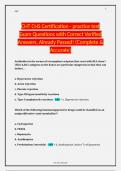1
CHT
CHT CHS Certification - practice test
Exam Questions with Correct Verified
Answers, Already Passed! (Complete &
Accurate)
Antibodies in the serum of a transplant recipient that react with HLA class I
(HLA-A,B,C) antigens on the donor are particular dangerous in that they can
induce...
a. Hyperacute rejection
b. Acute rejection
c. Chronic rejection
d. Type III hypersensitivity reactions
e. Type I anaphylactic reactions - ANS ✓a. Hyperacute rejection
Which of the following immunosuppressive drugs could be classified as an
antiproliferative (anti-metabolite)?
a. Cyclosporine
b. FK506
c. Rapamycin
d. Azathioprine
e. Prednisolone (steroids) - ANS ✓d. Azathioprine, induce T cell apoptosis
CHT CHS Certification
, 2
CHT
Recipients of organ transplants are generally required to take
immunosuppressive drugs for ...
a. 6 months
b. 2-5 years
c. 10-15 years
d. Until there is no evidence of rejection
e. For the remainder of their lives - ANS ✓e. For the remainder of their lives
If HLA-A, HLA-B and HLA-DR alleles are compared between a parent and a
child, how many would you typically expect to be matched?
a. Impossible to predict without DNA testing
b. None
c. 3
d. 4
e. 6 - ANS ✓c. 3
IgM differs from IgG in all of the following except...
a. Complement binding
b. Avidity
c. Molecular weight
d. Affinity
e. Kappa and lambda chains - ANS ✓e. Kappa and lambda chains
Dead cells stained with AO/EB appear orange because
CHT CHS Certification
, 3
CHT
a. Ethidium bromide prevents AO binding
b. AO leaks out of the dead cell, leaving only ethidium bromide
c. Ethidium bromide fluoresces much more strongly than AO
d. AO binds only RNA, which washes away when the cell is dead
e. Dead cells are actually orange. - ANS ✓c. Ethidium bromide fluoresces much
more strongly than AO. AO penetrate normal and early apoptotic cells with intact
membranes, fluorescing green when bound to DNA. EB only entire cells with
damaged membranes, such as late apoptotic and dead cells, emitting orange-red
fluorescence when bound to concentrated DNA fragments or apoptotic bodies
A patient with an anti-HLA-A2 antibody would likely have a PRA of?
a. 10%
b. 20%
c. 30%
d. 40%
e. Cannot tell without knowing the composition of the panel - ANS ✓e.
Cannot tell without knowing the composition of the panel
A patient with an anti-HLA-A2 antibody would be most likely to have a
positive T cell crossmatch with which of the following donors?
a. A1, A3, B8, B35, DR4, DR17
b. A1, A24, B7, B8, DR1, DR17
c. A24, A68, B7, B64, DR1, DR7
d. A11, A29, B38, B62, DR4, DR7
e. A1, A3, B35, B55, DR1, DR4 - ANS ✓c. A24, A68, B7, B64, DR1, DR7
CHT CHS Certification
, 4
CHT
A patient with an anti-HLA-Bw4 antibody would be most likely to have a
positive T cell crossmatch with which of the following donors?
a. A1, A3, B8, B35, DR4, DR17
b. A1, A24, B7, B8, DR1, DR17
c. A24, A68, B7, B64, DR1, DR7
d. A11, A29, B38, B62, DR4, DR7
e. A1, A3, B35, B55, DR1, DR4 - ANS ✓d. A11, A29, B38, B62, DR4, DR7
A patient with an anti-HLA-B8 CREG antibody might be expected to have a
positive T cell crossmatches with all of the following donors except?
a. A1, A3, B8, B35, DR4, DR17
b. A1, A24, B7, B8, DR1, DR17
c. A24, A68, B7, B64, DR1, DR7
d. A11, A29, B38, B62, DR4, DR7
e. A1, A3, B35, B55, DR1, DR4 - ANS ✓e. A1, A3, B35, B55, DR1, DR4
A positive AHG T cell crossmatch between an untransfused male recipient
and non-beaded spleen cells from the donor is most likely due to
a. Anti-Bw6
b. Macrophage contamination
c. Auto antibodies
d. CYNAP antibodies
e. Anti-HLA-DQ antibodies - ANS ✓b. Macrophage contamination
CHT CHS Certification




